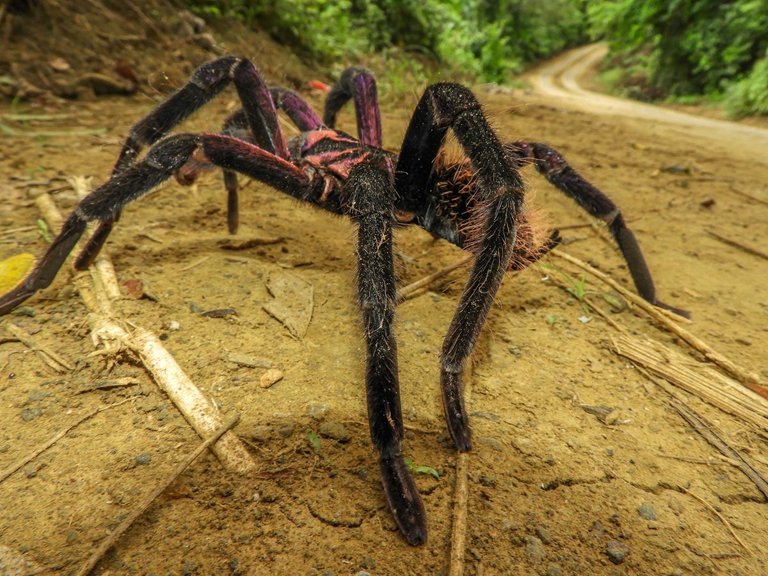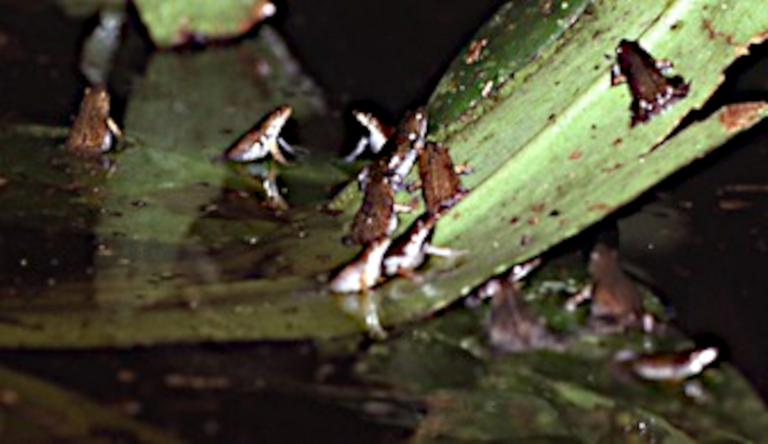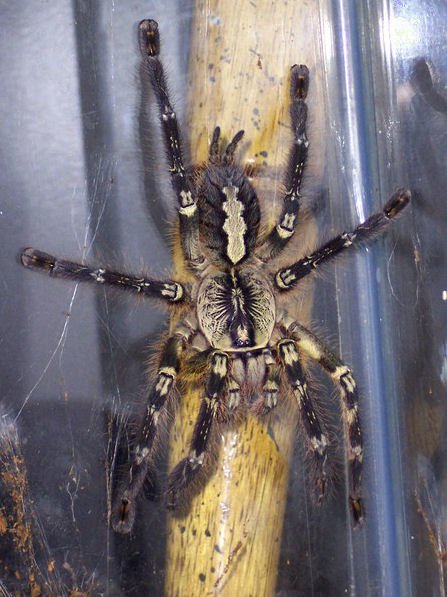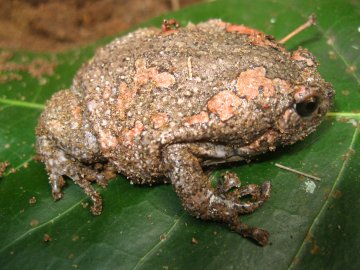Can a Tarantula and a Frog Get Along?
The idea for this blog came to me when I was brainstorming for a post in another community, LMAC. My mind was busily working on ideas for a collage in which an entire village was covered by a spider web. I wanted to put other creatures in the collage so I started to explore species with whom spiders might have a symbiotic, or mutualist relationship. Surprisingly, I found a tiny amphibian with whom a species of tarantula lives peacefully, in what is believed to be a mutualistic relationship.
The Dotted Humming Frog and the Colombian Lesserblack Tarantula
Colombian Lesserblack Tarantula, Xenesthis Immanis

Image credit: José Gabriel Julio Guzmán. Used under CC 4.0 license
According to the website Theraphosidae.be, which appears to be dedicated to offering information about Tarantulas, the Colombian Lesserblack Tarantula may be found in: Colombia, Venezuela, and Ecuador. This arachnid is described as a terrestrial (as opposed to arboreal) bird spider. The description apparently means the spider is large enough to eat birds--though birds may be only occasional fare.
Adults of both sexes reach a leg span of about 8". The spider is sexually dimorphic (there are apparent differences between the sexes in adulthood). Lifespan for female Xenesthis immanis may be 15 years. Males generally live to only 4 years. It's possible the shorter lifespan is partly due to the fact that the female sometimes eats the male after mating. Females are larger and heavier.
There is another species of tarantula that has a greater reputation for eating birds: the Goliath bird-eating spider. The Goliath is said to be the largest spider in the world.
Goliath Bird-Eating Spider
However, our featured spider today, the Colombian Lesserblack, is no slouch. It is known to eat a variety of animals, including small amphibians and insects. This is what makes its relationship with the tiny dotted humming frog so remarkable.
Dotted Humming Frog, Chiasmocleis Ventrimaculata

Image credit: Andreas Schlüter. Used under CC 2.5 license.
This minuscule frog (size range between 20-24mm), may be found in moist forests and marshes of Bolivia, Brazil, Colombia, Ecuador, and Peru. The males of the species 'sing' together in a chorus. According to Amphibia Web, this amphibian has "explosive reproduction".
Why do frogs 'sing'? Actually the sound a frog makes is its 'call' and that call is almost always sent out by the male. The Australian Museum suggests this gender-specific behavior has a mating purpose. The male is announcing his presence. The 'song' is a kind of come hither advertisement.
I couldn't find a recording of the dotted humming frog's call, I did find a compilation of frog calls on Youtube.
Despite its diminutive size and noisy habits,however, the dotted humming frog manages to avoid becoming dinner for the very large lesserblack tarantula. Not only does the frog avoid being eaten, it apparently enjoys protection from its ordinarily lethal companion. Here's a video showing frog and spider together:
It has been observed that both species benefit from this arrangement. What could the frog possibly offer the spider? Protection of the young.
The diet of the frog includes ants and flies. These opportunistic feeders would spell death to the young/eggs of the tarantula. By keeping the tiny frog around, the tarantula has a handy housekeeping staff.
There's a nice picture on this Twitterfeed of the frogs and the tarantula, with tarantula young, cohabitating on a leaf:
https://twitter.com/rainmaker1973/status/1248211500017254405?lang=en
The Colombian lesserblack tarantula happens to be very maternal, so the mother places high value on her young. She carries about a 100 spiderlings in her egg sack. The mother may live with her offspring for a year, and has been known to feed communally. Mother and young share tasty meals such as cockroaches, crickets, and small frogs. That is, small frogs that are not of the dotted humming variety.
Both the dotted humming frog and the Colombian lesserblack tarantula are nocturnal. The tarantula prefers to burrow in the ground. Often it is an opportunistic burrower.
Like all tarantulas, the Colombian lesserblack is a hunter. However, unlike some other tarantulas, the lesserblack does not spin a web. When night falls, it waits outside its burrow and pounces on prey. Legs attached to its abdomen are sensory organs and help the spider to detect prey, or to sense danger and flee.
Colombian Lesserblack Compared to Human Hand

Image credit: José Gabriel Julio Guzmán. Used under CC 4.0 license.
How does the Colombian lesserblack tarantula distinguish its amphibian housekeeper from other frogs which are destined to be dinner? It is believed that the tarantula recognizes its ally through smell. Researchers believe the reaction is instinctual. It has been observed that young tarantulas will jump on a frog and then move off and leave it in peace.
Not surprisingly, the Colombian lesserblack is considered a rather docile spider, as tarantulas go. If startled, it is more likely to retreat than attack. One of its first defensive measures would be to release irritating hairs (urticating setae) by raising the legs and exposing the abdomen. Here is a Youtube video explaining the way the spider uses these hairs (advance the video to around 2.16 to hear about this species).
While this tarantula is not considered highly venomous, it can inflict great harm through its setae (hairs). These may elicit strong allergic reactions and if inhaled could cause extreme respiratory distress. If embedded in the eye, they can cause severe damage.
Other Tarantulas Have Mutualistic Relationships
While doing this blog, I learned that this mutualism (between frog and tarantula) is not unique to South America. It occurs all over the world. The behavior has been observed in arboreal tarantulas in Sri Lanka and in a species of tarantula in Mexico.
Ornate Tiger Spider Poecilotheria Ornata, Sri Lanka

Image credit: Morkelsker. Used under public domain license. This tarantula is a fierce hunter but lives in peace (mutualistically) with the *Kaloula taprobanica * in the forests of Sri Lanka
Kaloula Taprobanica Frog, Also Known as Nagao's Pug-Snout Frog
Image credit: Vijayakumarblathur. Used under a CC 4.0 License.
According to the biologist Francesco Tomasinelli, mutualistic relationships between frogs and tarantulas may be more widespread, and involve more diverse species, than has so far been observed.
Conclusion
I learned about the mutualistic relationship between the tarantula and the frog while I was doing an art project. This serendipitous discovery supports my long-held conviction that there is not separation between art and science. If we are open to the interconnectedness of nature and the universe, then I believe we should also be open to the interconnectedness between so-called disciplines.
I hope you, my readers, are as entertained by my excursion into arachnids and amphibians as I have been. Who knows where blogging will take me tomorrow.
Wishing health, peace and a creative day to all. Thank you for reading my blog. Hive on!



Selected Sources Used in Writing This Blog
1.https://nationalzoo.si.edu/animals/goliath-bird-eating-tarantula
2.https://blogs.scientificamerican.com/tetrapod-zoology/tiny-frogs-and-giant-spiders-best-of-friends/
3.https://www.jstor.org/stable/2388434
4.http://www.isopoda.net/contents/the-odd-couple-spider-frog-mutualism-in-the-amazon-rainforest/
5.https://projects.ncsu.edu/cals/course/ent425/library/compendium/diptera.html
6.https://www.theraphosidae.be/en/xenesthis-immanis/
7.https://biomedicalephemera.tumblr.com/post/19439864037/xenestis-colombiana-xenesthis-immanis-the
8.https://www.inaturalist.org/taxa/25068-Chiasmocleis-ventrimaculata
9.https://www.ncbi.nlm.nih.gov/books/NBK535394/
10.https://beyondthetreat.com/xenesthis-immanis/
11.https://familylifegoals.com/these-giant-tarantulas-are-best-friends-with-tiny-frogs-and-the-relationship-is-one-of-natures-best/
12.https://scienceblogs.com/tetrapodzoology/2009/07/03/tiny-frogs-and-giant-spiders
13.https://kidadl.com/animal-facts/colombian-lesserblack-tarantula-facts
14.https://www.youtube.com/
15.https://tapro.sljol.info/articles/abstract/10.4038/tapro.v1i1.2772/
16.https://en.wikipedia.org/wiki/Uperodon_nagaoi
17.https://www.youtube.com/
18.https://forums.frontier.co.uk/threads/most-beautiful-tarantulas-spiders-to-be-added-wishlist.526449/

Electronic-terrorism, voice to skull and neuro monitoring on Hive and Steem. You can ignore this, but your going to wish you didnt soon. This is happening whether you believe it or not. https://ecency.com/fyrstikken/@fairandbalanced/i-am-the-only-motherfucker-on-the-internet-pointing-to-a-direct-source-for-voice-to-skull-electronic-terrorism
Electronic-terrorism, voice to skull and neuro monitoring on Hive and Steem. You can ignore this, but your going to wish you didnt soon. This is happening whether you believe it or not. https://ecency.com/fyrstikken/@fairandbalanced/i-am-the-only-motherfucker-on-the-internet-pointing-to-a-direct-source-for-voice-to-skull-electronic-terrorism
I remember seeing snippets about this relationship around the net.
Truly, nature is fascinating.
I saw there was a lot of information, that it had been circulating for a while, but it was new to me. Disappointed I couldn't find a recording of the humming frog chorus :)) I'll keep looking.
Interesting and a really fascinating mutualistic relationship. I totally agree that there's a thin line between art and science.
Hello @gentleshaid. Thank you. The wonderful part about this process is that as I began to explore the science implications of my question, a community existed that would welcome this sort of exploration. Thank you for reading and curating. What a great blockchain, where we can segue from one idea to another, seamlessly.
Thanks for your contribution to the STEMsocial community. Feel free to join us on discord to get to know the rest of us!
Please consider supporting our funding proposal, approving our witness (@stem.witness) or delegating to the @stemsocial account (for some ROI).
Thanks for including @stemsocial as a beneficiary, which gives you stronger support. Using the STEMsocial app could yield even more supporti next time.
Thank you STEMsocial. I had fun researching and writing this. It's great to have that effort appreciated.
Wow! what a way to establish relations between the frog and tarantulas. I believe that tarantula can think and love so that's possible. I have even heard that people get along with them or even pet them so why not! Tarantulas are venomous alright but not fatal.
Hi @sunnyag, Isn't this cool? There are so many things in the world I don't know. So much stuff to learn and write about. Don't you love blogging? And when readers like you come along and comment, that's the cherry on top.
Thanks so much. If you happen to come across a recording of the dotted humming frogs 'singing', pass it on. I'd love to hear it :))
Have a great evening (or whatever it is where you live).
Thank you, I would love to give you a recording of doted frog singing. They do it during rainy season so if you want my personal recording, you will have to wait for now. Have a nice & tight sleep!
I can't tell you how much that video pleased me. Thank you so very much. I'm going to forward it to my Ipad and listen to it as I go to sleep.
🌼🌼
Glad to be of some help :)
Wow amazing, Interesting and a really fascinating mutualistic relationship
Thank you very much! After writing this I got interested in frogs. I never paid them much attention. Funny how the more we know, the more we want to know.
I appreciate that you read my long blog. Have a great night.
Thank you so much sir.